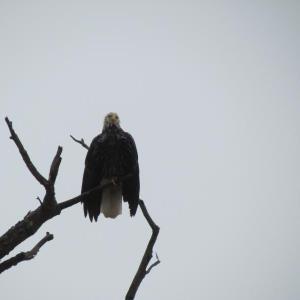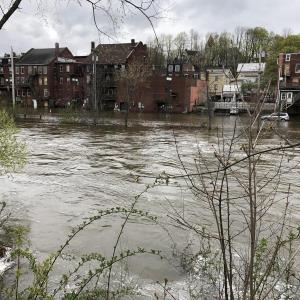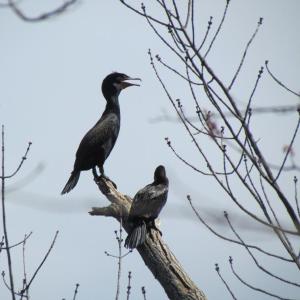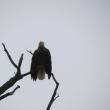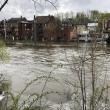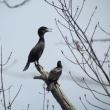Floods and Fish-eating Birds
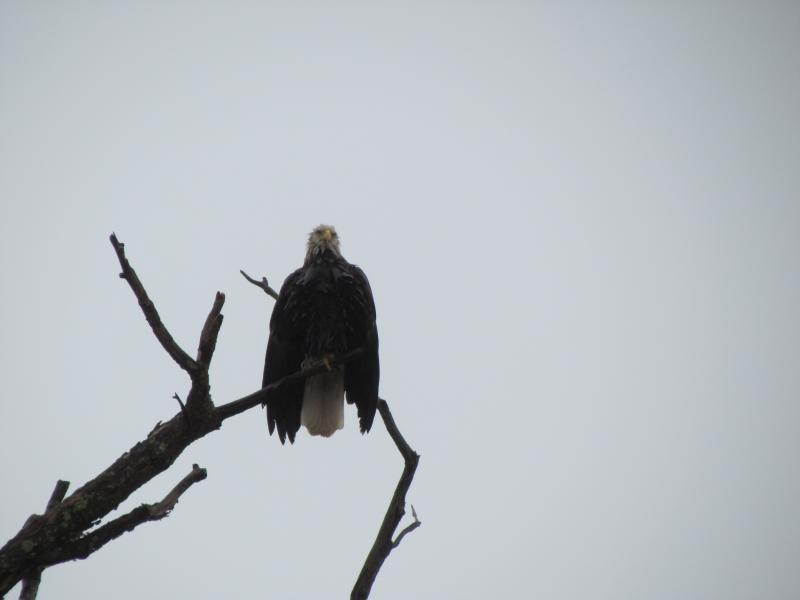 A soggy bald eagle waits out the rain and resulting flooding along the Kennebec River. (Photo courtesy of Allison Wells)
A soggy bald eagle waits out the rain and resulting flooding along the Kennebec River. (Photo courtesy of Allison Wells)
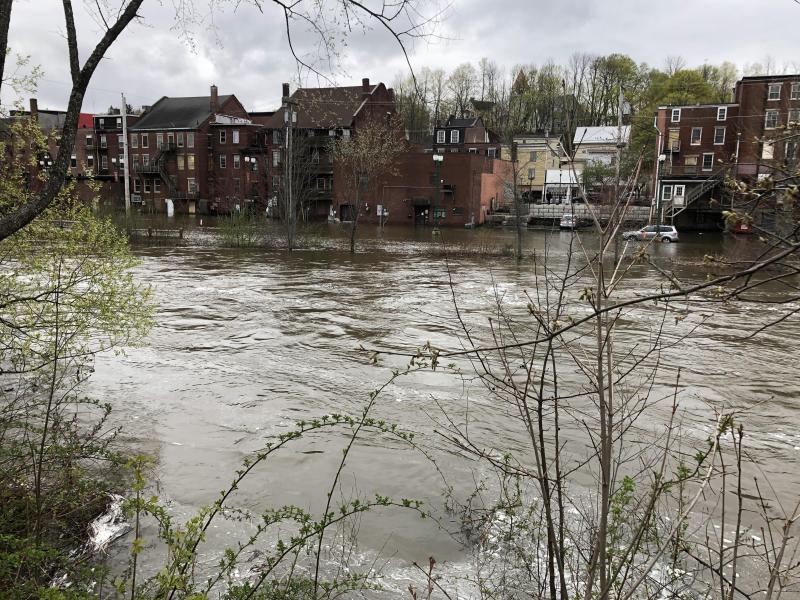 Recent rains caused the waters of Cobboseecontee Stream to rise 16 feet above normal, flooding into some buildings in downtown Gardiner. (Photo courtesy of Allison Wells)
Recent rains caused the waters of Cobboseecontee Stream to rise 16 feet above normal, flooding into some buildings in downtown Gardiner. (Photo courtesy of Allison Wells)
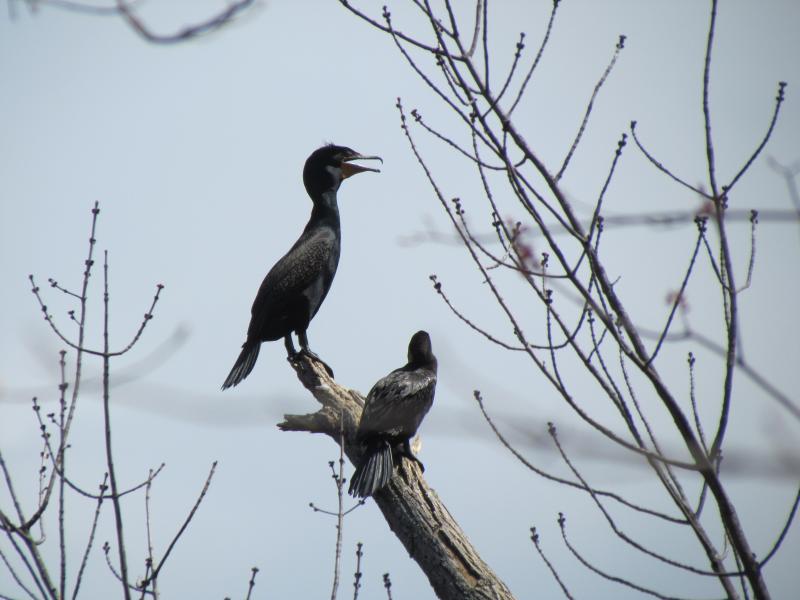 Double-crested cormorants waiting for a good time to go fishing. (Photo courtesy of Jeff Wells)
Double-crested cormorants waiting for a good time to go fishing. (Photo courtesy of Jeff Wells)
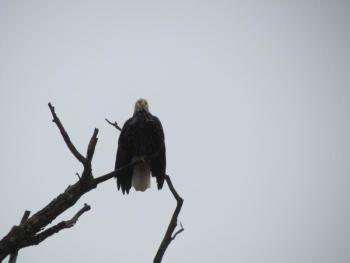 A soggy bald eagle waits out the rain and resulting flooding along the Kennebec River. (Photo courtesy of Allison Wells)
A soggy bald eagle waits out the rain and resulting flooding along the Kennebec River. (Photo courtesy of Allison Wells)
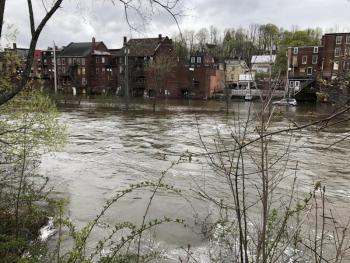 Recent rains caused the waters of Cobboseecontee Stream to rise 16 feet above normal, flooding into some buildings in downtown Gardiner. (Photo courtesy of Allison Wells)
Recent rains caused the waters of Cobboseecontee Stream to rise 16 feet above normal, flooding into some buildings in downtown Gardiner. (Photo courtesy of Allison Wells)
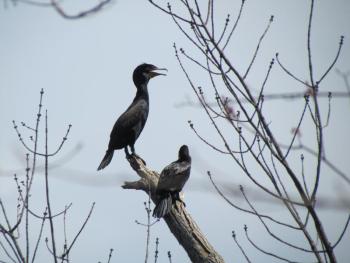 Double-crested cormorants waiting for a good time to go fishing. (Photo courtesy of Jeff Wells)
Double-crested cormorants waiting for a good time to go fishing. (Photo courtesy of Jeff Wells)
The heavy rains last week in Central Maine brought some major flooding across many parts of our region. By one estimate, a month’s worth of rain fell in about 24 hours. As that water collected upstream and began flowing together from various tributaries, the result was an unstoppable massive force. Culverts overflowed, roads were damaged and in a few cases, washed away. Electricity was knocked out for thousands, and in places like Augusta, Hallowell, and Gardiner along the banks of the Kennebec River, flood waters rose across parking lots and into the ground floors of buildings.
Birds, too, must cope with heavy rains and floods. Fish-eating birds are, of course, immediately impacted by flooding. When immense quantities of muddy water are rushing through formerly slow moving or shallow waters, resident fish will find places with slower moving water, often deeper or behind rocks or other safe places. Anadromous fish (those that migrate into freshwater systems from the sea to spawn and then move back out again) like alewives may be able to leave and go back to the ocean until the flooding abates, as has been found in some other migratory fish species.
All of this means that birds like ospreys, bald eagles, and double-crested cormorants probably went hungry during the flooding last week in our area. We noticed ospreys in a number of places sitting soaked and hunched over during the very high waters (fortunately, in the last few days, they have resumed flying over with fish as the waters in at least some spots are closer to normal). Cormorants trying to feed in places like the Kennebec River would seem to likely have been completely out of luck between the muddiness of the water and its extremely fast flow, and also because the water was filled with trees, sticks, and other debris that would have seemingly made it rather hazardous to be swimming in.
As the storm waters began to recede, we did see some cormorants attempting to ride the still-swift waters where Cobbosseecontee Stream flows into the Kennebec River in Gardiner. Sometimes very swift and high waters can flush fish out so that a particular stream can take a few years for its fish population to recover to former levels. This is conjecture on our part, but we have wondered whether fish pushed downstream from upper reaches of a watershed could end up, perhaps in a weakened condition, at a spot where the flow is lessened. If so, maybe those cormorants were actually finding some new prey that would not have been there before the flooding.
The small aquatic insects (things like the larvae of caddisflies, mayflies, dragonflies) found in shallow streams can also be pushed out by scouring currents that can occur in floods. These insects are the food of fish, so places like the mouth of the Cobbosseecontee Stream, once the flooding had lessened, could also have been a potential bonanza for fish eating up those insects. If that had attracted lots of fish, then maybe the cormorants were trying to catch the fish that were trying to catch the insects.
We’ve barely touched on the ways in which major rain storms and flooding can impact birds and bird habitat, including through creating temporary ponds and wetlands (what we wrote about as “pop-up ponds” in a previous column)— storm-caused structural changes to the banks of streams and rivers, changes to marine and freshwater systems through the addition of sediments, nutrients and pollutants, and damage to nests from heavy rains and winds (here in Maine, only a few birds are nesting this early, thankfully).
Wildlife have evolved to cope with floods, of course, but the concern today is that major flooding events are predicted to become more frequent with human-induced climate change now rapidly underway. Efforts to lower carbon emissions are crucial to give wildlife (and ourselves) a fighting chance of coping with heavier floods like these in the future.
Jeffrey V. Wells, Ph.D., is a Fellow of the Cornell Lab of Ornithology and Vice President of Boreal Conservation for National Audubon. Dr. Wells is one of the nation's leading bird experts and conservation biologists. He is a coauthor of the seminal “Birds of Maine” book and author of the “Birder’s Conservation Handbook.” His grandfather, the late John Chase, was a columnist for the Boothbay Register for many years. Allison Childs Wells, formerly of the Cornell Lab of Ornithology, is a senior director at the Natural Resources Council of Maine, a nonprofit membership organization working statewide to protect the nature of Maine. Both are widely published natural history writers and are the authors of the popular books, “Maine’s Favorite Birds” (Tilbury House) and “Birds of Aruba, Bonaire, and Curaçao: A Site and Field Guide,” (Cornell University Press).

